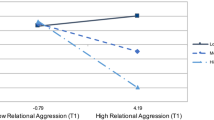Abstract
The purpose of these studies was to examine the frequency and stability of relational and physical aggression and their associations with social-psychological adjustment or peer victimization, and how friendships are involved in the relations between forms of aggression and peer victimization in Japanese children. The sample consisted of 452 (Study 1) and 138 (Study 2) children who were in the fourth and fifth grades. Results of Study 1 demonstrated that relational aggression was uniquely and more strongly associated with internalizing adjustment problems than physical aggression. Moreover, Study 2 revealed that relational aggression and physical aggression were stable over a 6-month period and the stability of relational aggression was reinforced by negative friendships (i.e., high levels of exclusivity and friend victimization). Further, the association between relational aggression and relative increases in relational victimization was attenuated by positive friendships (i.e., high levels of intimacy, companionship, and friendship satisfaction). Interestingly, friendships were unrelated to physical aggression and its relation to physical victimization. The age and gender of the children in the two studies were also examined. Cultural and developmental processes involving forms of aggression, friendships, social-psychological adjustment, and peer victimization were discussed.


Similar content being viewed by others
Notes
Additional two-way interaction terms (i.e., physical aggression × gender, relational aggression × gender, physical aggression × grade, and relational aggression × grade) were entered in order to examine the role of gender and age in the association between relational aggression or physical aggression and social-psychological adjustment problems. We found that most interaction terms were not significant. Thus, these results were not included in final models. One exception was the significant relational aggression × gender interaction for externalizing adjustment problems. A follow-up mixed linear model revealed that the relation between relational aggression and externalizing adjustment problems was significant only for boys (B = 0.25, p < 0.001, B = −0.12, n.s., for boys and girls, respectively).
Additional interaction terms (i.e., relational aggression × gender or grade, positive friendship × relational aggression × gender or grade, and negative friendship × relational aggression × gender or grade) were entered in order to examine the role of gender or age in the association between relational aggression and criterion variables and the role of gender and age in the moderating effect of friendship quality on these associations. We found that no interaction terms were significant and improved the overall model fit. Thus, the results were not included in final models.
Additional interaction terms (i.e., physical aggression × gender or grade, positive friendship × physical aggression × gender or grade, and negative friendship × physical aggression × gender or grade) were entered in order to examine the role of gender and age in the association between physical aggression and criterion variables and the role of gender and age in the moderating effect of friendship quality on these associations. We found that most interaction terms were not significant. One exception was the significant positive friendship × physical aggression × grade interaction for physical aggression at time 2. However, the overall model fit did not improve by adding these interaction terms. This indicated that the quality of the additional model was questionable. Thus, the results were not included in final models.
References
Achenbach, T. M. (1991). Manual for the child behavior checklist 14–18 and 1991 profile. Burlington: University of Vermont Department of Psychiatry.
Bandura, A. (1977). Social learning theory. Englewood Cliffs: Prentice Hall.
Bjorkqvist, K. (1994). Sex differences in physical, verbal, and indirect aggression: a review of recent research. Sex Roles, 30, 177–188.
Card, N. A., Stucky, B. D., Sawalani, G. M., & Little, T. D. (2008). Direct and indirect aggression during childhood and adolescence: a meta-analytic review of gender differences, intercorrelations, and relations to maladjustment. Child Development, 79, 1467–8624.
Cohen, S., & Wills, T. A. (1985). Stress, social support, and the buffering hypothesis. Psychological Bulletin, 98, 310–357.
Coie, J. D., & Kupersmidt, J. B. (1983). A behavioral analysis of emerging social status in boys’ groups. Child Development, 54, 1400–1416.
Cote, S., Vaillancourt, T., Barker, T., Nagin, D., & Tremblay, R. E. (2007). The joint development of physical and indirect aggression: predictors of continuity and change during childhood. Development and Psychopathology, 19, 37–55.
Crick, N. R. (1996). The role of overt aggression, relational aggression, and prosocial behavior in the prediction of children’s future social adjustment. Child Development, 67, 2317–2327.
Crick, N. R., & Grotpeter, J. K. (1995). Relational aggression, gender, and social-psychological adjustment. Child Development, 66, 710–722.
Crick, N. R., & Zahn-Waxler, C. (2003). The development of psychopathology in females and males: current progress and future challenges. Development and Psychopathology, 15, 719–742.
Crick, N. R., Werner, N. E., Casas, J. F., O’Brien, K. M., Nelson, D. A., Grotpeter, J. K., et al. (1999). Childhood aggression and gender: A new look at an old problem. In D. Bernstein (Ed.), Nebraska symposium on motivation (pp. 75–141). Lincoln: University of Nebraska Press.
Crick, N. R., Ostrov, J. M., & Werner, N. E. (2006). A longitudinal study of relational aggression, physical aggression and children’s social-psychological adjustment problems. Journal of Abnormal Child Psychology, 34, 131–142.
Crick, N. R., Ostrov, J. M., & Kawabata, Y. (2007). Relational aggression and gender: An overview. In D. J. Flannery, A. T. Vazsonyi, & I. D. Waldman (Eds.), The Cambridge handbook of violent behavior (pp. 245–259). New York: Cambridge University Press.
Cullerton-Sen, C., & Crick, N. R. (2005). Understanding the effects of physical and relational victimization: the utility of multiple perspectives in predicting social-emotional adjustment. School Psychology Review, 34, 147–160.
De Vos, G. A. (1996). Psychocultural continuities in Japanese social motivation. In D. W. Shwalb & B. J. Shwalb (Eds.), Japanese childrearing: Two generations of scholarship (pp. 44–84). New York: Guilford Press.
Ministry of Education, Culture, Sports, Science, and Technology—Japan. (2004). A report concerning problematic behaviors of elementary school children. Retrieved from http://www.mext.go.jp/b_menu/houdou/16/08/04082302/all.pdf.
Enomoto, J. (1999). Socio-emotional development of friendship among adolescents: activities with friends and the feeling for friends. Japanese Journal of Educational Psychology, 47, 180–190.
Enomoto, J. (2000). Friendship among adolescents: needs and their relation to emotions and activities. Japanese Journal of Educational Psychology, 48, 444–453.
French, D. C., Jansen, E. A., & Pidada, S. (2002). United States and Indonesian children’s and adolescents’ reports of relational aggression by disliked peers. Child Development, 73, 1143–1150.
Galen, B. R., & Underwood, M. K. (1997). A developmental investigation of social aggression among children. Developmental Psychology, 33, 589–600.
Grotpeter, J. K., & Crick, N. R. (1996). Relational aggression, overt aggression, and friendship. Child Development, 67, 2328–2338.
Hart, C. H., Nelson, D. A., Robinson, C. C., Olsen, S. F., & McNeilly-Choque, M. K. (1998). Overt and relational aggression in Russian nursery-school-age children: parenting style and marital linkages. Developmental Psychology, 34, 687–697.
Hartup, W. W., & Stevens, N. (1997). Friendships and adaptation in the life course. Psychological Bulletin, 121, 355–370.
House, J. S., Umberson, D., & Landis, K. R. (1988). Structures and processes of social support. Annual Review of Sociology, 14, 293–318.
Itani, T., Kanbayashi, Y., Nakata, Y., Kita, M., Fujii, H., Kuramoto, H., et al. (2001). Standardization of Japanese version of the child behavior checklist/4–18. Psychiatria et Neulrologia Paediatrica Japonica, 41, 243–252.
Johnson, F. A. (1993). Dependency and Japanese socialization. New York: New York University Press.
Kawabata, Y., Crick, N. R., & Hamaguchi, Y. (2010). The role of culture in relational aggression: A link to social-psychological adjustment problems among Japanese and U.S. school-aged children. International Journal of Behavioral Development.
Koizumi, S. (1991). The standardization of children’s depression inventory. Syoni Hoken Kenkyu [The Journal of Child Health], 50, 717–721.
Kovacs, M. (1985). The children’s depression inventory. Psychopharmacology Bulletin, 21, 995–998.
Maccoby, E. E. (1990). Gender and relationships. American Psychologist, 45, 513–520.
Markus, H. R., & Kitayama, S. (1991). Culture and the self: implications for cognition, emotion, and motivation. Psychological Review, 98, 224–253.
Morita, Y., Soeda, H., Soeda, K., & Taki, M. (1999). Japan. In P. K. Smith, Y. Morita, J. Junger-Tas, D. Olweus, R. Catalano, & P. Slee (Eds.), The nature of school bullying: A cross-national perspective (pp. 309–323). New York: Routledge.
Murray-Close, D., Ostrov, J. M., & Crick, N. R. (2007). A short-term longitudinal study of growth of relational aggression during middle childhood: associations with gender, friendship intimacy, and internalizing problems. Development and Psychopathology, 19, 187–203.
Raudenbush, S. W., & Bryk, A. S. (2002). Hierarchical linear models: Applications and data analysis methods (2nd ed.). Newbury Park: Sage.
Rose, A. J., & Rudolph, K. D. (2006). A review of sex differences in peer relationship processes: potential trade-offs for the emotional and behavioral development of girls and boys. Psychological Bulletin, 132, 98–131.
Rose, A. J., Swenson, L. P., & Waller, E. M. (2004). Overt and relational aggression and perceived popularity: developmental differences in concurrent and prospective relations. Developmental Psychology, 40, 378–387.
Rothbaum, F., Pott, M., Azuma, H., Miyake, K., & Weisz, J. (2000). The development of close relationships in Japan and the United States: paths of symbiotic harmony and generative tension. Child Development, 71, 1121–1142.
Sakai, A., & Yamasaki, K. (2004). Development of proactive and reactive aggression questionnaire for elementary school children. Japanese Journal of Psychology, 75, 254–261.
Sakurai, S. (1995). Educational social psychology on apathy. Tokyo: Kazama shobou.
Shimizu, H. (2000). Japanese cultural psychology and empathic understanding: implications for academic and cultural psychology. Ethos, 28, 224–247.
Smith, P. K., Cowie, H., Olafsson, R. F., & Liefootghe, A. P. D. (2002). Definitions of bullying: a comparison of terms used, and age and gender differences in a fourteen-country international comparison. Child Development, 73, 1119–1133.
Vaillancourt, T., Brendgen, M., Boivin, M., & Tremblay, R. (2003). Longitudinal confirmatory factor analysis of indirect and physical aggression: evidence of two factors over time? Child Development, 74, 1628–1638.
Werner, N. E., & Crick, N. R. (2004). Peer relationship influences on the development of relational and physical aggression during middle childhood: the roles of peer rejection and association with aggressive friends. Social Development, 13, 495–513.
Author information
Authors and Affiliations
Corresponding author
Additional information
This study was funded in part by the Institute of Child Development (ICD) through the second author. We thank the principals, teachers, parents and children for their participation. Portions of this paper were presented at the biennial meeting of the Society for Research in Child Development, Atlanta, GA, April, 2005.
Rights and permissions
About this article
Cite this article
Kawabata, Y., Crick, N.R. & Hamaguchi, Y. Forms of Aggression, Social-Psychological Adjustment, and Peer Victimization in a Japanese Sample: The Moderating Role of Positive and Negative Friendship Quality. J Abnorm Child Psychol 38, 471–484 (2010). https://doi.org/10.1007/s10802-010-9386-1
Published:
Issue Date:
DOI: https://doi.org/10.1007/s10802-010-9386-1




